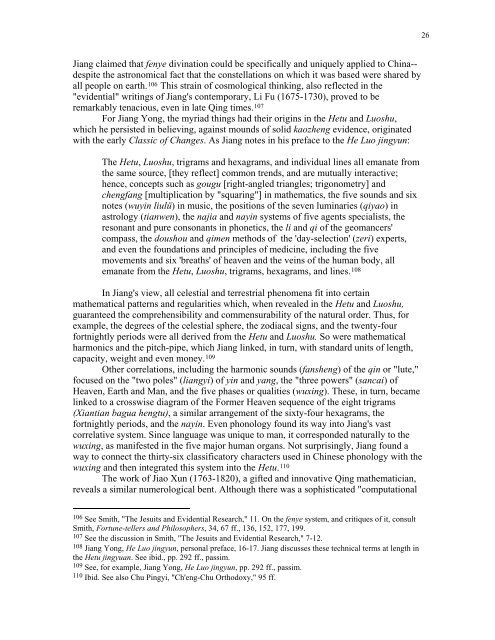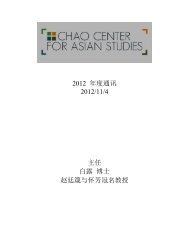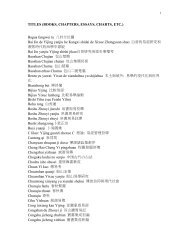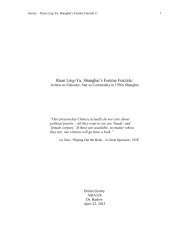Jesuit Interpretations of the Yijing - Chao Center for Asian Studies ...
Jesuit Interpretations of the Yijing - Chao Center for Asian Studies ...
Jesuit Interpretations of the Yijing - Chao Center for Asian Studies ...
Create successful ePaper yourself
Turn your PDF publications into a flip-book with our unique Google optimized e-Paper software.
26<br />
Jiang claimed that fenye divination could be specifically and uniquely applied to China--<br />
despite <strong>the</strong> astronomical fact that <strong>the</strong> constellations on which it was based were shared by<br />
all people on earth. 106 This strain <strong>of</strong> cosmological thinking, also reflected in <strong>the</strong><br />
"evidential" writings <strong>of</strong> Jiang's contemporary, Li Fu (1675-1730), proved to be<br />
remarkably tenacious, even in late Qing times. 107<br />
For Jiang Yong, <strong>the</strong> myriad things had <strong>the</strong>ir origins in <strong>the</strong> Hetu and Luoshu,<br />
which he persisted in believing, against mounds <strong>of</strong> solid kaozheng evidence, originated<br />
with <strong>the</strong> early Classic <strong>of</strong> Changes. As Jiang notes in his preface to <strong>the</strong> He Luo jingyun:<br />
The Hetu, Luoshu, trigrams and hexagrams, and individual lines all emanate from<br />
<strong>the</strong> same source, [<strong>the</strong>y reflect] common trends, and are mutually interactive;<br />
hence, concepts such as gougu [right-angled triangles; trigonometry] and<br />
chengfang [multiplication by "squaring"] in ma<strong>the</strong>matics, <strong>the</strong> five sounds and six<br />
notes (wuyin liulü) in music, <strong>the</strong> positions <strong>of</strong> <strong>the</strong> seven luminaries (qiyao) in<br />
astrology (tianwen), <strong>the</strong> najia and nayin systems <strong>of</strong> five agents specialists, <strong>the</strong><br />
resonant and pure consonants in phonetics, <strong>the</strong> li and qi <strong>of</strong> <strong>the</strong> geomancers'<br />
compass, <strong>the</strong> doushou and qimen methods <strong>of</strong> <strong>the</strong> 'day-selection' (zeri) experts,<br />
and even <strong>the</strong> foundations and principles <strong>of</strong> medicine, including <strong>the</strong> five<br />
movements and six 'breaths' <strong>of</strong> heaven and <strong>the</strong> veins <strong>of</strong> <strong>the</strong> human body, all<br />
emanate from <strong>the</strong> Hetu, Luoshu, trigrams, hexagrams, and lines. 108<br />
In Jiang's view, all celestial and terrestrial phenomena fit into certain<br />
ma<strong>the</strong>matical patterns and regularities which, when revealed in <strong>the</strong> Hetu and Luoshu,<br />
guaranteed <strong>the</strong> comprehensibility and commensurability <strong>of</strong> <strong>the</strong> natural order. Thus, <strong>for</strong><br />
example, <strong>the</strong> degrees <strong>of</strong> <strong>the</strong> celestial sphere, <strong>the</strong> zodiacal signs, and <strong>the</strong> twenty-four<br />
<strong>for</strong>tnightly periods were all derived from <strong>the</strong> Hetu and Luoshu. So were ma<strong>the</strong>matical<br />
harmonics and <strong>the</strong> pitch-pipe, which Jiang linked, in turn, with standard units <strong>of</strong> length,<br />
capacity, weight and even money. 109<br />
O<strong>the</strong>r correlations, including <strong>the</strong> harmonic sounds (fansheng) <strong>of</strong> <strong>the</strong> qin or "lute,"<br />
focused on <strong>the</strong> "two poles" (liangyi) <strong>of</strong> yin and yang, <strong>the</strong> "three powers" (sancai) <strong>of</strong><br />
Heaven, Earth and Man, and <strong>the</strong> five phases or qualities (wuxing). These, in turn, became<br />
linked to a crosswise diagram <strong>of</strong> <strong>the</strong> Former Heaven sequence <strong>of</strong> <strong>the</strong> eight trigrams<br />
(Xiantian bagua hengtu), a similar arrangement <strong>of</strong> <strong>the</strong> sixty-four hexagrams, <strong>the</strong><br />
<strong>for</strong>tnightly periods, and <strong>the</strong> nayin. Even phonology found its way into Jiang's vast<br />
correlative system. Since language was unique to man, it corresponded naturally to <strong>the</strong><br />
wuxing, as manifested in <strong>the</strong> five major human organs. Not surprisingly, Jiang found a<br />
way to connect <strong>the</strong> thirty-six classificatory characters used in Chinese phonology with <strong>the</strong><br />
wuxing and <strong>the</strong>n integrated this system into <strong>the</strong> Hetu. 110<br />
The work <strong>of</strong> Jiao Xun (1763-1820), a gifted and innovative Qing ma<strong>the</strong>matician,<br />
reveals a similar numerological bent. Although <strong>the</strong>re was a sophisticated "computational<br />
106 See Smith, "The <strong>Jesuit</strong>s and Evidential Research," 11. On <strong>the</strong> fenye system, and critiques <strong>of</strong> it, consult<br />
Smith, Fortune-tellers and Philosophers, 34, 67 ff., 136, 152, 177, 199.<br />
107 See <strong>the</strong> discussion in Smith, "The <strong>Jesuit</strong>s and Evidential Research," 7-12.<br />
108 Jiang Yong, He Luo jingyun, personal preface, 16-17. Jiang discusses <strong>the</strong>se technical terms at length in<br />
<strong>the</strong> Hetu jingyuan. See ibid., pp. 292 ff., passim.<br />
109 See, <strong>for</strong> example, Jiang Yong, He Luo jingyun, pp. 292 ff., passim.<br />
110 Ibid. See also Chu Pingyi, "Ch'eng-Chu Orthodoxy," 95 ff.








